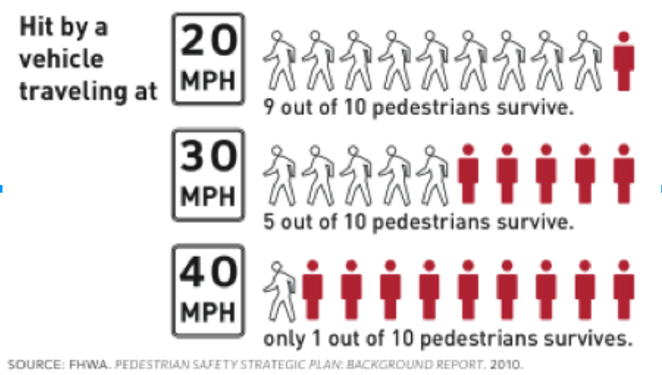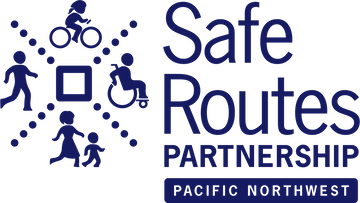This is an update to our earlier coverage of changes to speed setting authority and methodology in Oregon – read our previous post here.
Earlier this year, we followed activity in the Oregon legislative and regulatory arenas relating to how local jurisdictions and the state are able to set speed limits. Currently, Oregon speed limits are established by statute or through a traffic engineering study, and are largely based on the guidance that speed limits should be within 10 mph of the 85th percentile observed speed. As a reminder, the 85th percentile is the speed at which 85 percent of people drive at or below on a street.
There’ve been a few developments worth sharing since our earlier coverage, including the passage of SB 558, a bill that authorizes all cities and counties to set speeds 5 mph lower than highway statutory speed. We submitted testimony in support of this measure, because we believe delegating speed setting authority locally will allow for speeds to be set based on local context and more quickly, efficiently, and consistently across street types.
HB 2702 was the other bill we’d hoped would pass during the 2019 Legislative Session, as it would have expanded ODOT’s authorization to delegate speed setting authority to cities and counties -- not just for highways that are low-volume or unpaved, but for any road locally owned. The bill didn’t pass, but the issue has been taken up by ODOT for review during the interim. Earlier this month, we listened in to a meeting held by the Oregon Speed Zone Review Panel, as they reviewed and provided recommendations on draft Oregon Administrative Rules (OARs) pertaining to the establishment of speed zones.
The draft OARs and recommendations from the Speed Review Panel would make several changes to how local jurisdictions may adjust speeds; here are some of the most notable:
1. Establishes different context zones based on land use, such as rural, rural town, suburban, urban and urban core, for determining how and where speeds may be changed.

2. The draft OARs suggest setting speeds based on the above land use context zones in combination with the function of the road: freeway, principal arterial, minor arterial, collectors and local.

3. Proposes target posted speeds for roads based on context & function, with speeds starting at 20 mph and ranging up to 65 mph. Among the proposed target posted speeds suggested in the draft OARs, urban core arterials and collectors would range 25 – 30 mph, while urban core & local roads would range 20 mph – 25 mph. Suburban roads would be set higher, starting at 30 mph. As for roads outside city limits, depending on the class of road and location, speeds would range greatly from 25 mph (rural communities) up to 65 mph (rural interstates).
4. The recommend speed within city limits could also be varied up to 10mph below the 50th percentile, for any of the following reasons: crash rates exceed 50% more than average, there’s been more than one fatal or serious injury in the past three years, and/or the specific section of road is part of a residence district.
We’re encouraged by the shift away from the 85th percentile, as it’s an outdated method that sets speed limits based on how fast cars are actually going, rather than what’s safe and appropriate for each context. The 85th percentile rule often requires local jurisdictions to increase their speed limits to dangerous rates, based on driver behavior. We also welcome the added flexibility for local jurisdictions to lower speeds, but we do have some initial concerns. One concern is in the details of the fourth bullet listed above, that would only allow a variation of up to 10mph below the 50th percentile if more than one fatality or serious injury occurred in the past three years. One death or serious injury is already too many, and three years isn’t a long enough window.
Another area of concern, is the proposed high speed rates set for suburban contexts. The higher the speed of traffic, the more likely a car is to kill a person. According to the FHWA, 9 out of 10 pedestrians survive being hit by a car traveling at 20 mph, versus the 9 out of 10 pedestrians who die from being struck by a car traveling at 40 mph. We would caution that suburban contexts also have high volumes of pedestrian and bicycle traffic, and speeds should be set lower in these areas.

Additionally, we’d like to see an elevated focus on built environment in these discussions. We know that lowering speeds is essential to increasing safety and reducing deaths, injuries and crashes. But we also know that simply lowering a speed doesn’t equal safer roads, roads still need to be designed or re-designed for the safety of people walking and rolling. And while these administrative rules might not be the technical place to address road design, it could certainly be an opportunity to raise the issue.
For a closer review, here are copies of the current draft OARs and definitions. A final draft is expected in September. We’ll continue following the discussion, and share updates as the public comment period opens this fall. In the meantime, let us know your thoughts!
Related articles & files:
- Current draft OARs and definitions.
- Oregon Speed Zone Review Panel August 14 meeting slides.


